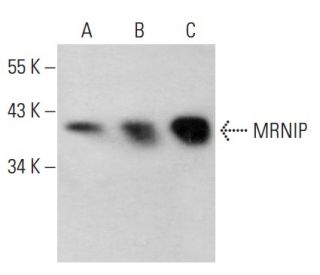
MRNIP Antibody (H-11): sc-390012
- MRNIP Antibody (H-11) is a mouse monoclonal IgG2b κ MRNIP antibody provided at 200 µg/ml
- specific for an epitope mapping between amino acids 231-263 within an internal region of MRNIP of human origin
- MRNIP Antibody (H-11) is recommended for detection of MRNIP of human origin by WB, IP, IF, IHC(P) and ELISA
- Anti-MRNIP Antibody (H-11) is available conjugated to agarose for IP; HRP for WB, IHC(P) and ELISA; and to either phycoerythrin or FITC for IF, IHC(P) and FCM
- also available conjugated to Alexa Fluor® 488, Alexa Fluor® 546, Alexa Fluor® 594 or Alexa Fluor® 647 for WB (RGB), IF, IHC(P) and FCM, and for use with RGB fluorescent imaging systems, such as iBright™ FL1000, FluorChem™, Typhoon, Azure and other comparable systems
- also available conjugated to Alexa Fluor® 680 or Alexa Fluor® 790 for WB (NIR), IF and FCM; for use with Near-Infrared (NIR) detection systems, such as LI-COR®Odyssey®, iBright™ FL1000, FluorChem™, Typhoon, Azure and other comparable systems
- m-IgG2b BP-HRP is the preferred secondary detection reagent for MRNIP Antibody (H-11) for WB and IHC(P) applications. This reagent is now offered in a bundle with MRNIP Antibody (H-11) (see ordering information below).
QUICK LINKS
SEE ALSO...
MRNIP Antibody (H-11) is a mouse monoclonal IgG2b kappa light chain antibody that detects MRNIP protein of human origin by western blotting (WB), immunoprecipitation (IP), immunofluorescence (IF), immunohistochemistry, and enzyme-linked immunosorbent assay (ELISA). anti-MRNIP antibody (H-11) is available in both non-conjugated and various conjugated forms, including agarose, horseradish peroxidase (HRP), phycoerythrin (PE), fluorescein isothiocyanate (FITC), and multiple Alexa Fluor® conjugates. MRNIP plays a crucial role in the DNA damage response, particularly in the repair of double-strand breaks, which is vital for maintaining genomic stability and preventing tumorigenesis. MRNIP interaction with key proteins involved in the repair process, such as RAD51 and BRCA1, underscores MRNIP importance in cellular responses to DNA damage. Dysregulation of MRNIP has been implicated in various cancers, making MRNIP a significant target for research in cancer biology and therapeutic development. With 181 million base pairs encoding around 1,000 genes, chromosome 5, where MRNIP is located, is associated with several genetic disorders, including Cockayne syndrome and familial adenomatous polyposis, highlighting the broader implications of MRNIP in human health.
Alexa Fluor® is a trademark of Molecular Probes Inc., OR., USA
LI-COR® and Odyssey® are registered trademarks of LI-COR Biosciences
MRNIP Antibody (H-11) References:
- Duodenal adenomatosis in familial adenomatous polyposis coli. A review of the literature and results from the Heidelberg Polyposis Register. | Kadmon, M., et al. 2001. Int J Colorectal Dis. 16: 63-75. PMID: 11355321
- The gene for Treacher Collins syndrome maps to the long arm of chromosome 5. | Dixon, MJ., et al. 1991. Am J Hum Genet. 49: 17-22. PMID: 1676560
- Cockayne syndrome exhibits dysregulation of p21 and other gene products that may be independent of transcription-coupled repair. | Cleaver, JE., et al. 2007. Neuroscience. 145: 1300-8. PMID: 17055654
- A new genomic mechanism leading to cri-du-chat syndrome. | South, ST., et al. 2006. Am J Med Genet A. 140: 2714-20. PMID: 17103439
- Redefining monosomy 5 by molecular cytogenetics in 23 patients with MDS/AML. | Herry, A., et al. 2007. Eur J Haematol. 78: 457-67. PMID: 17391336
- Somatic APC mosaicism: a frequent cause of familial adenomatous polyposis (FAP). | Aretz, S., et al. 2007. Hum Mutat. 28: 985-92. PMID: 17486639
- Telomerase reverse transcriptase haploinsufficiency and telomere length in individuals with 5p- syndrome. | Du, HY., et al. 2007. Aging Cell. 6: 689-97. PMID: 17875000
- Molecular mechanisms of skin aging: state of the art. | Makrantonaki, E. and Zouboulis, CC. 2007. Ann N Y Acad Sci. 1119: 40-50. PMID: 18056953
- MRNIP/C5orf45 Interacts with the MRN Complex and Contributes to the DNA Damage Response. | Staples, CJ., et al. 2016. Cell Rep. 16: 2565-2575. PMID: 27568553
- MRNIP condensates promote DNA double-strand break sensing and end resection. | Wang, YL., et al. 2022. Nat Commun. 13: 2638. PMID: 35551189
- MRNIP limits ssDNA gaps during replication stress. | Bennett, LG., et al. 2024. Nucleic Acids Res. 52: 8320-8331. PMID: 38917325
- A physical map of 15 loci on human chromosome 5q23-q33 by two-color fluorescence in situ hybridization. | Saltman, DL., et al. 1993. Genomics. 16: 726-32. PMID: 8325647
Ordering Information
| Product Name | Catalog # | UNIT | Price | Qty | FAVORITES | |
MRNIP Antibody (H-11) | sc-390012 | 200 µg/ml | $316.00 | |||
MRNIP Antibody (H-11): m-IgG2b BP-HRP Bundle | sc-548770 | 200 µg Ab; 10 µg BP | $354.00 | |||
MRNIP Antibody (H-11) AC | sc-390012 AC | 500 µg/ml, 25% agarose | $416.00 | |||
MRNIP Antibody (H-11) HRP | sc-390012 HRP | 200 µg/ml | $316.00 | |||
MRNIP Antibody (H-11) FITC | sc-390012 FITC | 200 µg/ml | $330.00 | |||
MRNIP Antibody (H-11) PE | sc-390012 PE | 200 µg/ml | $343.00 | |||
MRNIP Antibody (H-11) Alexa Fluor® 488 | sc-390012 AF488 | 200 µg/ml | $357.00 | |||
MRNIP Antibody (H-11) Alexa Fluor® 546 | sc-390012 AF546 | 200 µg/ml | $357.00 | |||
MRNIP Antibody (H-11) Alexa Fluor® 594 | sc-390012 AF594 | 200 µg/ml | $357.00 | |||
MRNIP Antibody (H-11) Alexa Fluor® 647 | sc-390012 AF647 | 200 µg/ml | $357.00 | |||
MRNIP Antibody (H-11) Alexa Fluor® 680 | sc-390012 AF680 | 200 µg/ml | $357.00 | |||
MRNIP Antibody (H-11) Alexa Fluor® 790 | sc-390012 AF790 | 200 µg/ml | $357.00 | |||
MRNIP (H-11) Neutralizing Peptide | sc-390012 P | 100 µg/0.5 ml | $68.00 |
